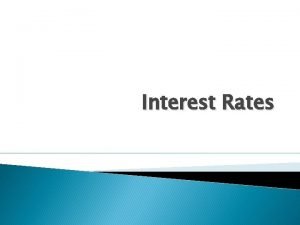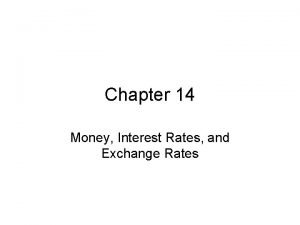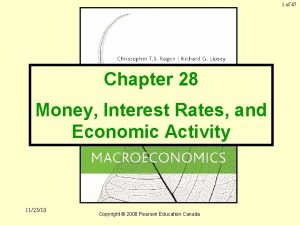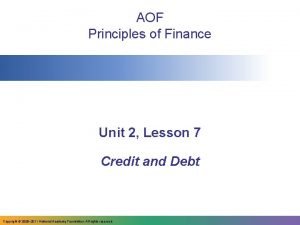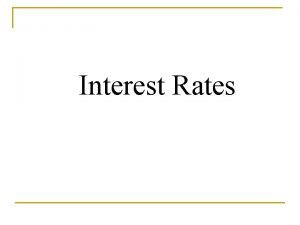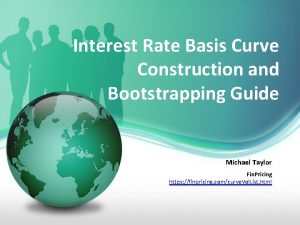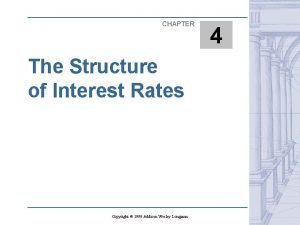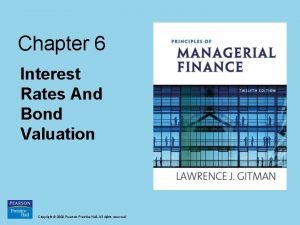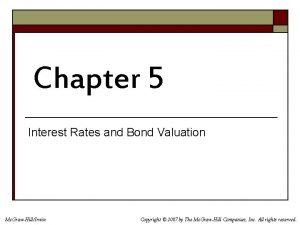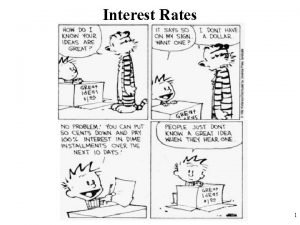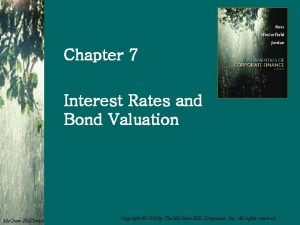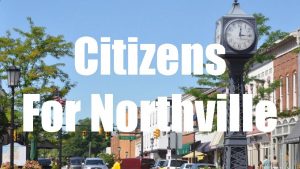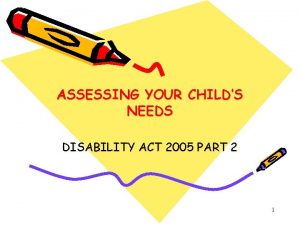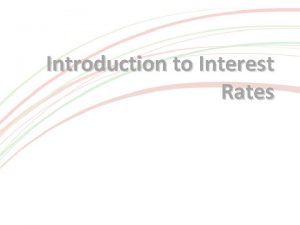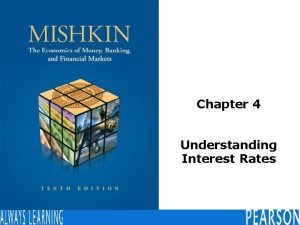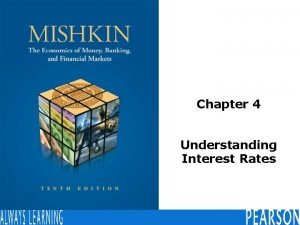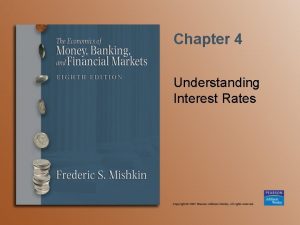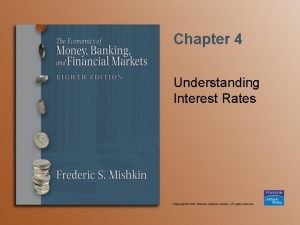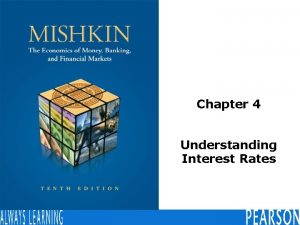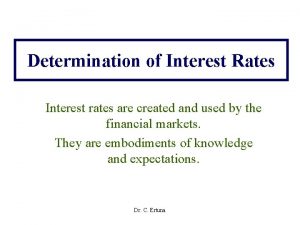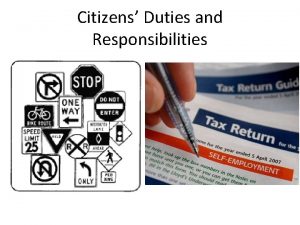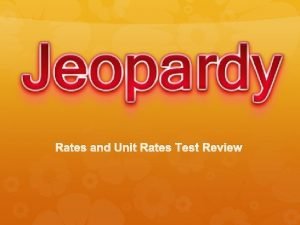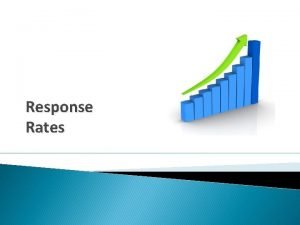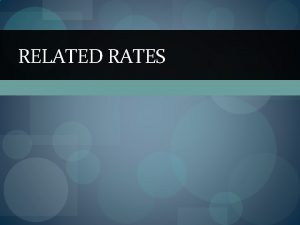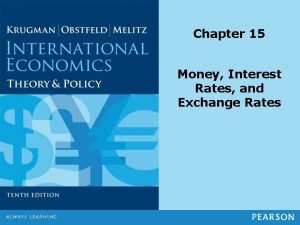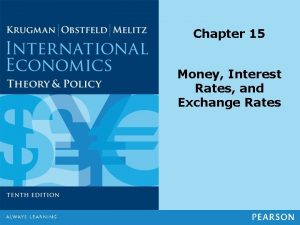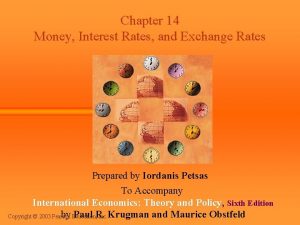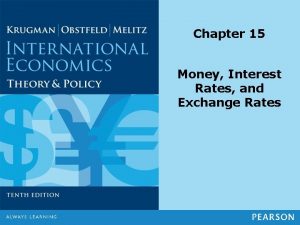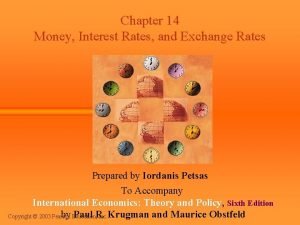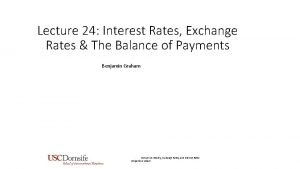A Citizens Guide to Interest Rates What most





























- Slides: 29

A Citizen’s Guide to Interest Rates What most people don’t know about what really makes our economy go. (…… but should)

The Secret Life of Interest Rates • The most important thing that interest rates do is to act as signals for the market. • Signal to save or borrow and spend. • ir also serve to ration the available supply of money to those who are willing and able to use it most efficiently in the long run. • Act as an automatic stabilizer to inflation.

Rationale • Much of the internal doings of the U. S. (and World) economy have to do with monetary and fiscal policy decisions which affect interest rates. • Any understanding of Economics is incomplete without knowledge of how interest rates affect and are affected by every other component of the economy. • Savings and Investment in Capital are where the individual interfaces with these policies. • Most individuals understand interest rates imperfectly if at all.

Key Topics Regarding ir • Identify models that should be used to demonstrate economic theories and discuss when to use which model. • Identify important concepts and how to apply them. • Discuss ir using appropriate vocabulary balancing jargon with concrete explanations in plain English.

Key Concepts • • • What are Interest Rates? Real vs. Nominal Money Supply and the Federal Reserve Money Demand Loanable Funds Market Fiscal policy and its impact on interest rates Crowding-Out Effect Bond Market Foreign Capital Injections and Leakages

The Relation Between Capital Investment and Interest Rates • Interest Rates DETERMINE the quantity of Capital Investment and Savings in the Economy. • Interest is the Opportunity Cost or “Price” paid for the use of money • Borrowers pay lenders for money to be used now, and repay later with interest • Savers earn interest because they are letting a lender use their money now • Lenders are financial intermediaries. • Interest rate is stated as a percentage

Real ir vs. Nominal ir • Appropriate abbreviations for Interest rate include “ir”, “i”, and “r” (always lower-case) • Nominal: loosely means “in name only” • Nominal ir discussed in terms of current price level • Real: loosely means “adjusted for inflation” • Real ir discussed in terms of actual purchasing power.

How Nominal and Real Relate Nominal ir – Inflation Rate = Real ir • (Calculate) • If Nominal ir goes up, Real ir doesn’t necessarily increase. • If Real ir goes up, Nominal ir will follow.

Graphic Models for ir • Interest rates play a role in various graphic models, the key is to figure out if they are nominal or real ir. • The Money Market Model is used to discuss the supply of money as defined by the FED. (nominal ir) • The Loanable Funds Market is used to reflect the saving and borrowing habits of the private sector. (real ir)

Money Market Model • Used to target the Fed Funds Rate through monetary policy. • Nominal ir • Should be used in conjunction with AD/AS and Investment Demand models (Next Slide) Money Market Model Nomin al ir MS MS 1 ir ir 1 MD QM QM 1 Quantity of Money

Money Market Linked to Demand for Capital Investment Nominal Expansionary Policy MS MS 1 Investment Demand Nominal ir ir 1 MD QM QM 1 Quantity of Money I I I 1 Quantity of Capital Investment

Investment Linked to AD/AS Investment in Capital Expansionary Policy Price level Nom -inal SRAS ir PL 1 ir PL ir 1 AD 1 (C+I 1+G) I I I 1 Quantity of Capital Investment 0 AD (C+I+G) Y Y 1 Real Gross Domestic Product

Loanable Funds Market • The Demand Curve for LF represents private demand for Loanable Funds. • The Supply Curve for LF represents private savings. • LF model represents the real ir. (abbrev. “r”) • Supply of LF (savings) sets the Prime Lending Rate. • Government borrowing to cover deficit spending will move DLF to the right. • Changes in the savings habits of the private sector shift SLF Real ir Loanable Funds Market SLF r DLF Quantity of Loanable Funds

Loanable Funds Theory of Interest • The supply of loanable funds comes from savers who deposit money in banks. • Supply is positively-sloped because people need an incentive to delay current spending. • Demand is negatively-sloped since higher ir discourage borrowing and spending. • Government borrows money from this market when taxes don’t cover the bills.

Control of Interest Rates • The majority of influence on interest rates comes from the private sector. • Rates react to changes in the individual desire of private citizens to consume or invest in capital. (or to save…) • Investment spending and the interest sensitive components of consumption spending are inversely related to interest rates. • The desire to save is positively related to ir.

Definitions of Money • The Money Supply is broken down into three categories: M 1: Cash, Currency, Checkable Deposits, NOW accounts, etc… M 2: Savings (under $100, 000), Short time deposits, CD’s, MMF’s, etc… M 3: Deposits in excess of $100, 000 and other long time deposits

The Demand for Money • This is a uniquely Macroeconomic concept • At any given time, there is a finite quantity of money in circulation (M 2 is Inelastic). • The transaction demand (M 1) depends on GDP because incomes = expenditures.

Fiscal Policy • Most expansionary government spending programs are financed through borrowing. • Budget deficits will increase the demand for loanable funds and cause real ir to rise • Contractionary fiscal policy will cause budget surplus • Budget surplus will reduce the demand for money and reduce interest rates

Deficit Spending • Government demands loanable funds to pay for deficit fiscal spending • By increasing the D for LF, the real ir increases. Loanable Funds Mkt. Real ir Qty. of Loanable Funds

Crowding Out • The increased real ir caused by deficit fiscal spending causes a decrease in private Investment spending and the interest-sensitive component of Consumption spending. • This lost investment and consumption is said to have been crowded out. • Crowding out is an effect, never a cause.

Crowding Out and AD/AS Deficit Fiscal Policy Real ir SLF (Private Savings) Price AD shifts to AD 1 when G increases Then shifts back to AD 2 as I falls due to the increase in interest rates. Level r 1 SRAS Pl 1 Pl 2 r PL AD 1 (C+I+G 1) DLF 1 (Private + Government) AD 2 I 1)+G 1) DLF (Private Demand) QLF 1 Quantity of Loanable Funds AD Y Y 2 Y 1 Real Gross Domestic Product (C+I+G) (C+

Barro-Ricardo Effect • The Barro-Ricardo Effect is feedback caused by a Crowding Out effect. • Higher interest rates associated with Crowding Out cause individuals to save more of their incomes. • The rise in savings increases the supply of loanable funds, thereby reducing the real interest rate. • The B-R effect has a smaller impact and usually doesn’t fully negate a crowding out effect.

Monetary Policy • Money is Neutral: any changes of the money supply can stabilize the economy. • Any attempt to grow the economy will result in inflation. • At any moment, the money supply is fixed • The supply of money is controlled by the Federal Reserve (the FED), using three main techniques. • Discount Rate, Fed Funds Rate, & Required Reserve Ratio.

Expansionary and Contractionary Policy • Expansionary Policies are used to increase the money supply (ex. Decrease RRR, Discount or Fed Funds Rate) • Contractionary Policies are used to reduce the money supply (ex. Raise RRR, Discount or Fed Funds Rate) • Interest rates increase and decrease in an inverse relationship with changes in the money supply.

The Discount Rate • This is the interest rate that banks pay to borrow emergency cash from the FED • Also known as the “Overnight” rate. • Short term loans cover checkable deposits held by the banks and the FED. • These are determined at the district level but are adjusted with input from D. C. • The FED is the lender of last resort.

Required Reserves Ratio • Banks are required to retain some of their deposits on hand in the form of vault cash or on deposit at a federal reserve bank. • The quantity of reserve is determined as a percentage of checkable deposits. • That percentage is called the RRR or Required Reserve Ratio. • 1/RRR = Simple Deposit Expansion Multiplier • The multiplier determines the total growth of the money supply from checkable deposits.

Fed Funds Rate • AKA the “Immediate rate”, it is the ir that banks charge each other to borrow money • The supply of money relative to the demand for it determines the ir. • The FFR is not set at a particular %, but is “targeted” by changing the money supply through the purchase or sale of bonds on the open market. • Buying bonds from the public pumps money into the economy, selling bonds takes money out of the system.

The Bond Market • Bonds are loans made to the government by individuals and institutions with a guaranteed rate of return and a clearly defined time limit. • Bond Prices and ir are inversely related • Governments (state, federal, and local) use the sale of bonds to pay for deficit spending. • The FED buys and sells bonds to stabilize the economy after deficit spending. • Bond rates send signals to both domestic and international buyers.

Net Foreign Investment • High Interest rates in the U. S. encourage net foreign investment in U. S. Bonds. D for $ rises, exports down, and imports up. • Low Interest Rates in the U. S. discourage net foreign investment in U. S. Bonds. D for $ falls, exports up, and imports down. • Increased Net Investment in U. S. Bonds is called Capital Inflow (or “Injection”). • Decreased Net Investment in U. S. Bonds is called Capital Outflow (or “leakage”).
 A rate is a ratio that compares
A rate is a ratio that compares Ratio guided notes
Ratio guided notes Ratios rates and unit rates
Ratios rates and unit rates Ratios rates and unit rates
Ratios rates and unit rates Interest rates and economic growth
Interest rates and economic growth Contractionary fiscal policy interest rate
Contractionary fiscal policy interest rate Financial risk definition
Financial risk definition Quotes about adjustments
Quotes about adjustments Chapter 7 interest rates and bond valuation
Chapter 7 interest rates and bond valuation Increase money supply
Increase money supply Interest rates and price level
Interest rates and price level Nominal.interest rate
Nominal.interest rate Determinants of interest rates
Determinants of interest rates How to find the price of a bond
How to find the price of a bond Unit 2 lesson 12 interest rates
Unit 2 lesson 12 interest rates What is real interest rate and nominal interest rate
What is real interest rate and nominal interest rate Interest rates
Interest rates Interest rate curve construction
Interest rate curve construction Interest rates
Interest rates Chapter 6 interest rates and bond valuation
Chapter 6 interest rates and bond valuation Interest rates
Interest rates Shifters of demand for loanable funds
Shifters of demand for loanable funds Chapter 7 interest rates and bond valuation
Chapter 7 interest rates and bond valuation Chapter 6 interest rates and bond valuation
Chapter 6 interest rates and bond valuation Simple and compound interest
Simple and compound interest Pnp insignia symbol
Pnp insignia symbol Action plan for senior citizens
Action plan for senior citizens Citizens for northville
Citizens for northville Disability act 2005 citizens information
Disability act 2005 citizens information 21 february in bd
21 february in bd







